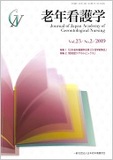Japanese
English
- 販売していません
- Abstract 文献概要
- 参考文献 Reference
抄録
経鼻胃管の使用率は嚥下機能障害のある入院高齢者で頻度が高いが,経鼻胃管留置中の経口摂取が,経口摂取の喪失に伴う苦痛を緩和し得るかは明らかではない.そこで本研究は,摂食状況別に比較した経口摂取の喪失に伴う苦痛(飲むこと,噛むこと,味わうことができない・食べたいものが食べられない,飲みたいものが飲めない・だれかと話ながら食事をする機会がない・他者の食事がさらされる・口渇)について明らかにした.対象者は都内医療機関3施設の入院高齢者29人で,嚥下機能障害で経鼻胃管留置中の者を適格基準に基づいて選定した.
非経口摂取群(n=14)と経口摂取群(n=15)で経口摂取の喪失に伴う苦痛の程度に差を認めなかった(p=.27).この苦痛のうち「食べたいものが食べられない・飲みたいものが飲めない」は経口摂取群で苦痛が弱く(p=.04),経口摂取により緩和され得ることが示唆された.経鼻胃管留置日数と経口摂取の喪失に伴う苦痛に負の相関関係を認め(r=−0.46,p=.01),留置日数30日未満の群は30日以上の群より苦痛が強かった(p<.01).経口摂取状況の変化に伴う苦痛への看護ケアは,早期に提供する必要性が示唆された.
Prevalence of nasogastric tube feeding is high among older adult inpatients with dysphagia. However, it is not known whether ingestion while intubated reduces distress from loss of oral intake. Therefore, this study examined the distress associated with loss of oral intake (inability to drink, inability to chew, inability to taste food, inability to eat and drink what was desired, deprived of opportunity to eat while socializing, being exposed to others' meals, and thirst) in each degree of ingestion.
Participants who were selected based on the eligible criteria were 29 older adult inpatients from three urban hospitals with nasogastric tubes for dysphagia from a variety of causes. The level of distress associated with loss of oral intake was not significantly different between the non-ingestion group (n=14) and the ingestion group (n=15) (p=.27). However, the distress level related to inability to eat and drink what they wanted was significantly lower in the ingestion group compared with the non-ingestion group (p=.04), therefore distress may be relieved by ingestion while being intubated. Furthermore the duration of intubation and the level of distress were negatively correlated (r=−0.46, p=.01). Distress level was significantly higher in the under 30 days compared to over 30 days for intubation (p<.01). The older adult inpatients receiving nasogastric tubes need early nursing care to address the potential distress related to alterations in their ingestion patterns.
Copyright © 2019, Japan Academy of Gerontological Nursing All rights reserved.


